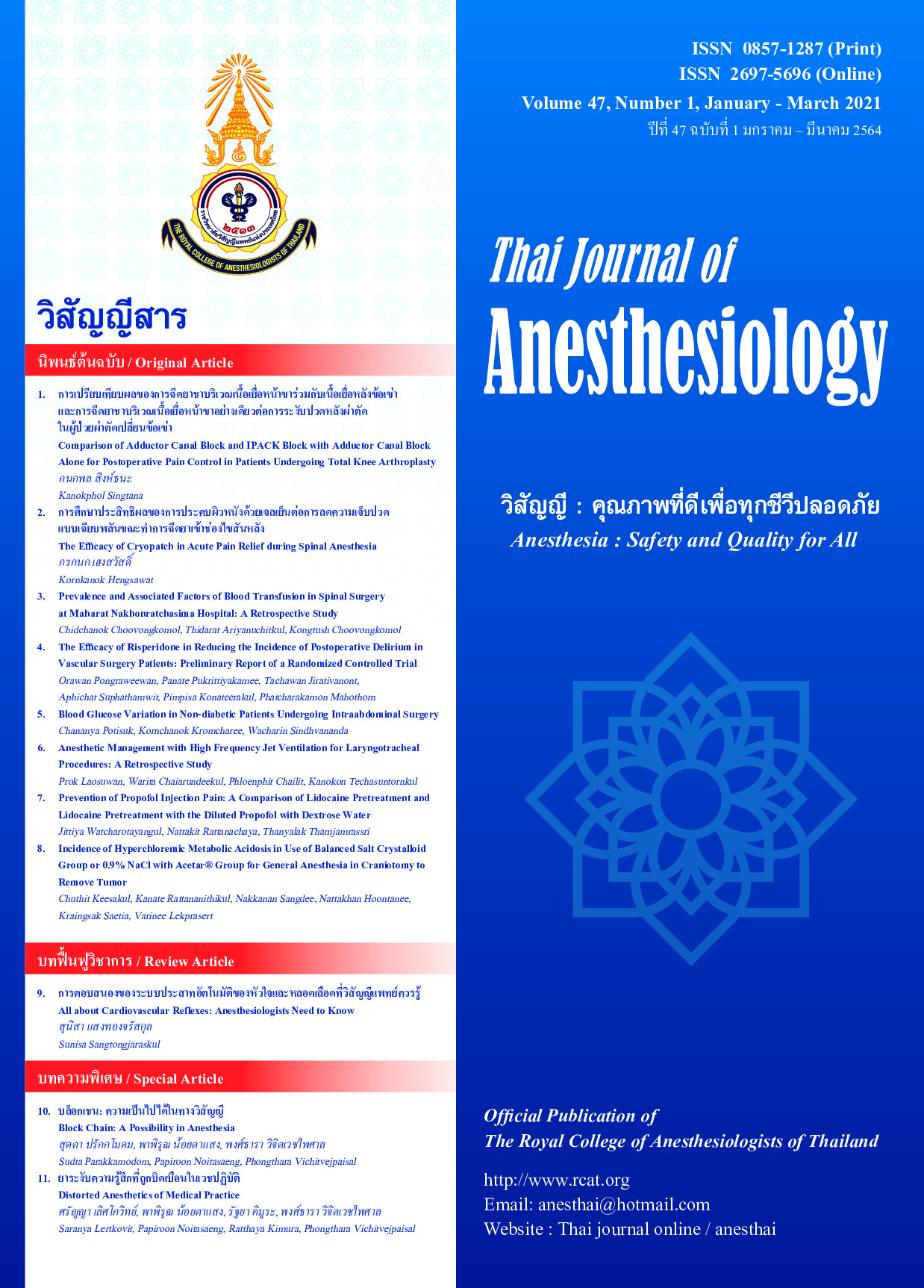Blood Glucose Variation in Non-diabetic Patients Undergoing Intraabdominal Surgery
Main Article Content
Abstract
Background: Perioperative hyperglycemia in
non-diabetes (non-DM) has been reported as much
as 30%. Glycemic variability (GV) becomes a better
predictive index of complications than hyperglycemia.
High GV in non-DM was associated with more severity of
complications than diabetes. There has been no study of
GV in non-diabetes undergoing intraabdominal surgery.
Objectives: To evaluate 1) incidence of hyperglycemia/
hypoglycemia 2) perioperative GV and 3) risk factors of
high GV
Methods: A prospective observational study was
performed after IRB approval. Adult non-diabetic patients
undergoing intraabdominal surgery were recruited.
Predicted operation time (<2 h) and planned sole regional
anesthesia were excluded. Selection criteria of non-DM
were defined. Blood glucose (BG) was monitored by POCT
every hour. Controls of BG were tight or non-tight controls
as appropriate. GV was calculated in the form of SD. Descriptive statistics and Mantel-Haenszel odds ratio
were used.
Results: Final patients of 120 were retained for analysis.
The 1st and 2nd most common types of surgery were hollow
viscus organ (50.83%) and solid organ (36.57%). Surgical
techniques was open (81.33%) and laparoscopic (16.67%)
approaches. Combined continuous epidural with general
anesthesia (CEA-GA) was performed (67.5%). Hyperglycemia
(>180 mg/dL) and hypoglycemia (<60 mg/dL) were 15%
and 5%, respectively. Patients with hyperglycemia of 15/18
(12.5%) received BG control. Hyperglycemia began during
the 2nd operative hour and mostly occurred in the 3rd hour.
44% of patients exhibited perioperative high GV. Solid organ
surgery was a significant risk factor (OR = 2.25).
Conclusion: Hyperglycemia, high GV and hypoglycemia
can occur in non-DM undergoing intraabdominal surgery.
Article Details
References
does inflammation induced hyperglycemia causes
mitochondrial dysfunction in immune cells? Bioessays
2019;41:e1800260.
2. Finnerty CC, Mabvuure NT, Ali A, Kozar RA, Herndon DN.
The surgically induced stress response. JPEN J Parenter
Enteral Nutr 2013;37(5 Suppl):21S-9S.
3. Goyal N, Kaur R, Sud A, Ghorpade N, Gupta M. Non diabetic
and stress induced hyperglycemia [SIH] in orthopaedic
practice what do we know so far? J Clin Diagn Res 2014;8:
doi: 10.7860/JCDR/2014/10027.5022
4. Frisch A, Chandra P, Smiley D, et al. Prevalence and clinical
outcome of hyperglycemia in the perioperative period in
noncardiac surgery. Diabetes Care 2011; 33:1783-8.
5. Shanks AM, Woodrum DT, Kumar SS, Campbell AD,
Kheterpal S. Intraoperative hyperglycemia is independently
associated with infectious complications after non-cardiac
surgery. BMC Anesthesiol 2018;18:90.
6. Kotagal M, Symons RG, Hirsch IB, et al. Perioperative
hyperglycemia and risk of adverse events among patients
with and without diabetes. Ann Surg 2015;261:97-103.
7. Fiorillo C, Rosa F, Quero G, Menghi R, Doglietto GB, Alfieri
S. Postoperative hyperglycemia in nondiabetic patients after
gastric surgery for cancer: perioperative outcomes. Gastric
Cancer 2017;20:536-42.
8. Capes SE, Hunt D, Malmberg K, Gerstein HC. Stress
hyperglycaemia and increased risk of death after myocardial
infarction in patients with and without diabetes: a systematic
overview. Lancet 2000;335:773-8.
9. Shohat N, Foltz C, Restrepo C, Goswami K, Tan T, Parvizi J.
Increased postoperative glucose variability is associated
with adverse outcomes following orthopaedic surgery. Bone
Joint J 2018;100-B:1125-32.
10. Ceriello A, Esposito K, Piconi L, et al. Oscillating glucose is
more deleterious to endothelial function and oxidative stress
than mean glucose in normal and type 2 diabetic patients.
Diabetes 2008;57:1349-54.
11. Duggan EW, Carlson K, Umpierrez GE. Perioperative
hyperglycemia management: An update. Anesthesiology
2017;126:547-60.
12. DeVries JH. Glucose variability: where it is important and
how to measure it. Diabetes 2013;62:1405-8.
13. Krinsley JS. Glycemic variability and mortality in critically ill
patients: the impact of diabetes. J Diabetes Sci Technol
2009;3:1292-301.
14. Gachabayov M, Senagore AJ, Abbas SK, Yelika SB, You K,
Bergamaschi R. Perioperative hyperglycemia: an unmet
need within a surgical site infection bundle. Techniques in
Coloproctology 2018;22:201-7.
15. Evans CH, Lee J, Ruhlman MK. Optimal glucose
management in the perioperative period. Surg Clin N Am
2015;95:337-54.
16. Piters KM, Kumar D, Pei E, Bessman AN. Comparison of
continuous and intermittent intravenous insulin therapy for
diabetics ketoacidosis. Diabetologia 1977;13:317-21.
17. Uemura F, Okada Y, Torimoto K, Tanaka Y. Relation between
hypoglycemia and glycemic variability in type 2 diabetes
patients with insulin therapy: a study based on continuous
glucose monitoring. Diabetes Technol Ther 2018;20:140-6.
18. Oka S, Deyama J, Umetani K, et al. Glycemic variability is
associated with myocardial damage in nondiabetic patients
with ST-elevation myocardial infarction. Cardiovascular
Endocrinology & Metabolism 2018;7:47-53.
19. Werner KT, Mackey PA, Castro JC, Carey EJ, Chakkera HA,
Cook CB. Hyperglycemia during the immediate period
following liver transplantation. Future Sci OA 2016;2:FSO97.
20. Altieri B, Tirabassi G, Casa SD, et al. Adrenocortical tumors
and insulin resistance: what is the first step? Int J Cancer
2016;138:2785-94.
21. Kim KJ, Jeong CY, Jeong SH, et al. Pancreatic diabetes
after distal pancreatectomy: incidence rate and risk factors.
Korean J Hepatobiliary Pancreat Surg 2011;15:123-7.


